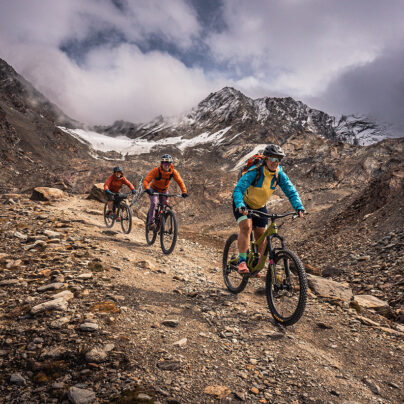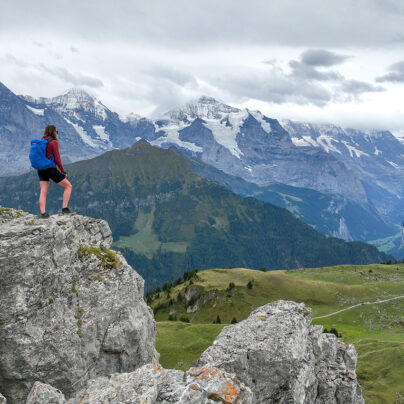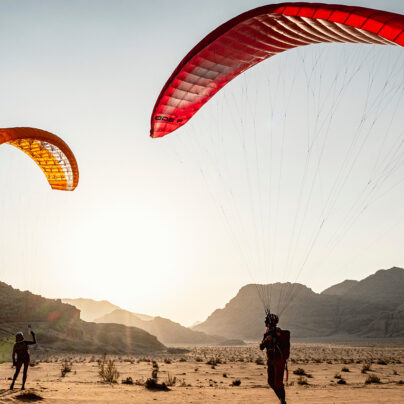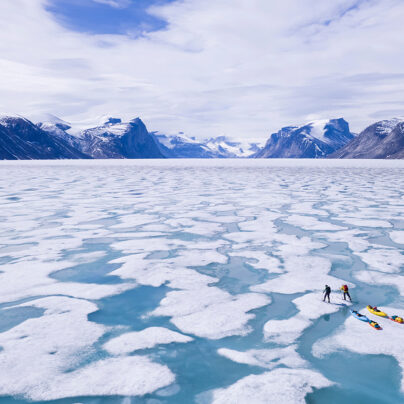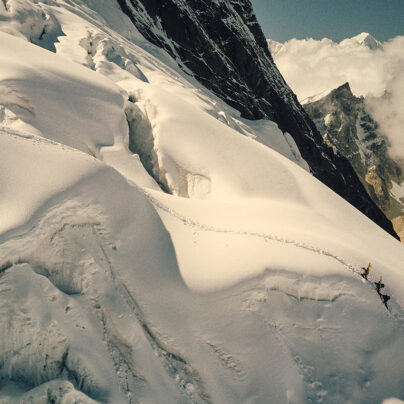Finding Solace on the Roof of Iraq
Jan Bakker
From the rooftop of our guest house we gaze at the sharp ridgeline that jacks up on the southern horizon. The terrain looks complex and the steep couloirs seem inaccessible. The only feasible access is via the west buttress of the ridge – but this is the Autonomous Region of Kurdistan in the north-east of Iraq, and this mountain ridge is right on the border with Iran. At the height of the Iraq-Iran War in the 1980s Saddam Hussein covered most of the easy terrain that could allow the enemy to invade with landmines. That legacy is still present in many parts of the border area today and venturing into these mountains requires careful route planning in collaboration with the local Kurds. As the sun disappears behind the ridge, our host and fixer Omar snaps us out of our dreamy state and beckons us to join him and his family for a generous, hearty plate of Kurdish specialities.
I’m in the city of Choman (which we nickname Chomanix) in the heart of the Iraqi Zagros Mountains with a team of three US war veterans and a film crew. The aim is to climb Mount Halgurd, a 3,607m-high mountain close to the Iranian border, and make the first known ski descent from its summit. It’s just 4m lower than its neighbour Cheekha Dar, which is considered the highest mountain in Iraq. The summit of Cheekha Dar is shared with Iran – and there’s an Iranian border patrol permanently perched on the top. Climbing it is probably not a good idea.
The driving force behind this expedition is US Army veteran Stacy Bare. Stacy is an imposing human being. Standing 6’6” tall with a shaved scalp and a big, bushy beard, one would probably steer clear of him in a dark alleyway. When we meet on the top floor of a posh hotel in Kurdistan’s capital Erbil he cracks a smile and gives me a huge bear hug despite never having met me before. Stacy served as a captain in the US Army in Iraq and cleared landmines for the Scotland-based HALO Trust in Angola and Abkhazia. These experiences had a profound impact on his psyche and after his return to the US he developed severe PTSD, pushing him into alcohol and drug abuse, and eventually to the brink of suicide. An introduction to rock climbing was the turnaround moment and he developed an appetite for adventure sports. Now a National Geographic Adventurer of the Year, Stacy is an advocate for adventure sports as a way to heal the mental wounds of PTSD through his non-profit organisation Adventure Not War.
The terrain looks complex and the steep couloirs seem inaccessible. The only feasible access is via the west buttress of the ridge – but this is the Autonomous Region of Kurdistan in the north-east of Iraq, and this mountain ridge is right on the border with Iran.



As the team prepares for the summit bid I look at the flickering lights of the Iranian border posts on the shared summits in the distance. In return, I’m sure they’ll be keeping an eye on the movements of our head torches. It’s still well below freezing level and the skins underneath our skis have a hard time finding grip on the refrozen slopes.
The voice of the muezzin echoes through the Choman Valley as we load the beat-up Toyota Land Cruisers with food and equipment in the early hours. We set off as first light trickles in from the east and the contours of the mountains become visible around us. The dirt track winds its way up through the bleak terraced fields that are still in winter mode. We pass mud-brick farmhouses and fenced-off fields, littered with red triangular signs bearing a white skull. Minefields. Suddenly, the reality of a ski expedition in this part of the world sinks in, and our concerns shift from the lack of snow to the objective danger of unexploded ordnance scattered across these border mountains. ‘Don’t worry about landmines!’ our local guide Reband assures us with a smile. ‘We have done this route many times, just not on skis.’
The motorised part of the journey comes to an end when the track is swallowed by spindrift at an elevation of around 2,000m. It’s another 600m of vertical gain to our base camp at the foot of Halgurd. We skin up and start pulling the makeshift pulkas through the slushy snow. The sun is in full force now and we worry about the snow conditions higher up the mountain – it’s February but it seems that spring has arrived early this year. After four frustrating hours of ploughing through knee-deep, wet snow, we reach a small flat plateau below the craggy south summit of Halgurd. It’s a perfect spot for our base camp, including a snow wall to dig out the kitchen. I’m calling in with the home front to check the latest weather forecast on the mountain. A blizzard with a metre of snow is forecasted in 48 hours, which forces us to change our planned acclimatisation/recce day tomorrow into a summit day.
Team member Matthew Griffin, known as Griff to friends, tells about his time as an American Army Ranger in Mosul, which is only 160km west from our base camp. He is the co-founder and owner of Combat Flip Flops, a US-based company that puts part of its profits back into conflict zones by supporting small local businesses, women’s education, and rebuilding communities. Above all, Griff is a fierce advocate for peace and diplomacy, often asked to share his opinion on the big US television networks. After listening to his compelling tales of life in a combat zone we call it an early night.
The buzzer rudely awakens us at 3.00am. As the team prepares for the summit bid I look at the flickering lights of the Iranian border posts on the shared summits in the distance. In return, I’m sure they’ll be keeping an eye on the movements of our head torches. It’s still well below freezing level and the skins underneath our skis have a hard time finding grip on the refrozen slopes. The past week has been unusually warm, resulting in an unwelcome freeze-thaw cycle. It’s still dark and we’re contouring around a landmine zone, marked by barely visible markers. Our Kurdish guide Reband reassures us we’re headed in the right direction.




The effect of the warm weather becomes apparent with the daylight coming in. Our route suffers large snow-free patches, forcing us to strap the skis on our packs and hike up a steep part of Halgurd. An hour behind schedule we reach the foot of the summit ridge. We grab our axes, step in to our crampons, and start climbing the crux of the ascent: 300 vertical metres up mixed terrain to reach the corniced ridge between the north and south summits. Directly next to the spur that we are climbing is our main objective: a beautiful line through a wide couloir just underneath the summit. Robin, who served as a helicopter pilot in Fallujah, has a stern look on her face. ‘I haven’t been so scared since my time as a heli pilot in Iraq,’ she admits. Her aircraft was shot down on a mission near Fallujah and she barely made it out alive. The other team members nod in silence. Neither is a professional athlete and the exposure is intimidating.
The east-facing 45˚ slope is still in good condition and we decide to solo the route to make up for the time loss lower on the mountain. Behind us the Zagros Mountains unfold, washed in blistering sunlight. The summit of Cheekha Dar is just 1km away as the crow flies. It doesn’t seem to have any skiable lines – a large diagonal rock band blocks any possible descent. As we head up we aim for a small gap in the corniced rim, giving us access to the broad ridge between the two Halgurd summits.
After a short hike, the team reaches the summit of Mount Halgurd. Having been deployed in Iraq’s lowland deserts the veterans could never have imagined a place like this existed within Iraq’s borders. With relief and contemplation, fallen friends are remembered. The first ski descent of this beautiful mountain is only a bonus and a mere excuse for experiencing the war-torn country in a different way: ‘Rewrite my ending in Iraq,’ as Stacy would say. I never served in the Army but through the stories shared by Stacy, Robin, and Griff during this expedition I can begin to guess the inner struggle veterans deal with after coming back from active combat. Climbing mountains must help.
Jan Bakker was born in a Dutch village below sea level. After seeing his first mountain at the age of 16, he has been exploring and guiding in remote mountain regions across the globe ever since. He recently finished the first printed trekking guidebook to Tajikistan which includes trekking in the Afghan Wakhan Corridor.
Blog: trekkinginthepamirs.com
Instagram: @jb37north
This expedition was organised by Untamed Borders




